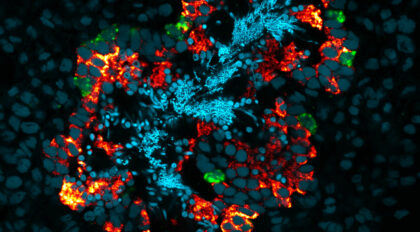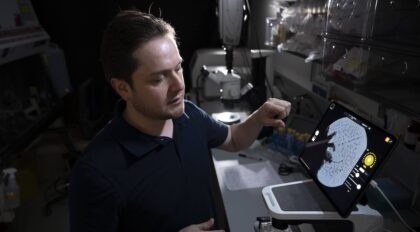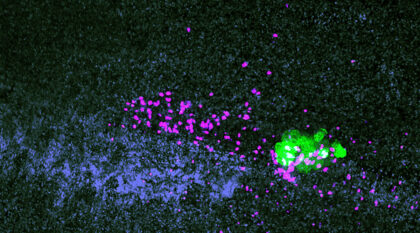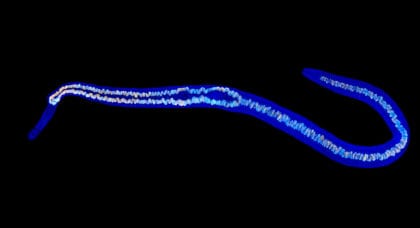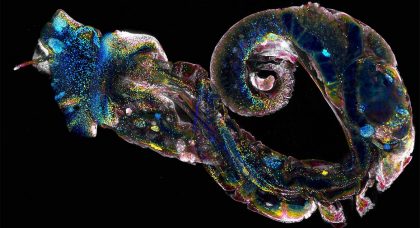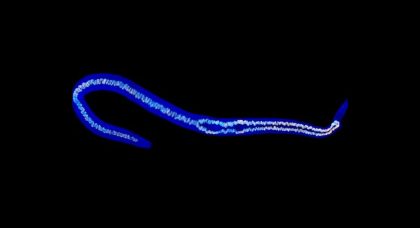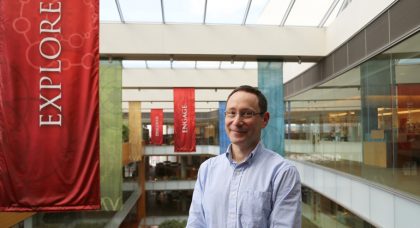Tag: Newmark Lab
The American investment in research is about people
Early-career scientists are essential to the Morgridge mission, and the majority have some level of competitive support from the National Institutes of Health (NIH). Here, early-career researchers share thoughts on how federal funding supports their mission to conduct high-impact research.
The infinite worm
Scooped from a fountain in Spain, a colony of planarians help scientists unravel the rules of regeneration.
Following the ‘BATT Signal’: A new signaling pathway controlling planarian germ cells
Morgridge scientists have discovered a surprising new way that the model organism planaria initiates sexual development.
Rising Sparks: Andrés Tibabuzo, regenerative biology
From ‘Jurassic Park’ to snake venom to parasitic flatworms, Andrés Tibabuzo is motivated by the science that fascinates him.
Photos: How Sea Spiders and Other Creatures Could Unlock the Secrets of Tissue Regeneration
via Wall Street Journal
Many animals have the ability to regrow limbs and other body parts after injury. A Wall Street Journal photo essay explores scientific inquiries into these amazing creatures — including the work of Melanie Issigonis in the Phil Newmark Lab at Morgridge.
Stem cell research uncovers clues to unique evolution in planarian reproduction
A new stem cell study describes genetic factors that support the development of germ cells and yolk cells in the reproductive organs of planarian flatworms.
Study sheds light on how planarians regenerate germ cells
Unlike virtually all animals, the flatworm planaria has the ability to regenerate its germ cells from anywhere in the body. The Morgridge Newmark Lab is finding the molecular footprint of this process for the first time.
Where are they now? Catching up with recent alumni in their new careers
A few of our recent Morgridge alumni reflect on how their research experience at the institute prepared them for their scientific careers.
UGA’s Rozario receives NIH Director’s New Innovator Award
via University of Georgia
Tania Rozario, a 2020 alumna of the Phil Newmark Regenerative Biology Lab at Morgridge, has received a National Institutes of Health Director’s New Innovator Award for high-risk, high-reward research she is pursuing as a University of Georgia professor.
Cell atlas of schistosome may hold key for new treatments
via Sanger Institute
Morgridge postdoctoral fellow Jayhun Lee is a lead author in a new study that outlines the first-ever cell atlas of the tropical parasite schistosome, an advance that could provide new alternatives for fighting a disease that impacts more than 200 million people globally.
How schistosome worms defy host immune systems
via SciDev.Net
Morgridge researchers uncovered in a new study how schistosomes, parasitic flatworms that infect more than 200 million people in the tropics, trick the host’s immune system and continue producing eggs for decades.
The big gulp: Inside-out protection of parasitic worms against host defenses
A team of developmental biologists at the Morgridge Institute for Research has discovered a means by which schistosomes, parasitic worms that infect more than 200 million people in tropical climates, are able to outfox the host’s immune system.
Seize the Moment: Adapting old tools for a novel coronavirus
Morgridge scientists John Brubacher, Anthony Gitter, Brian Bockelman, Ben Cox and Katie Overmyer, joined Gabriella Gerhardt on July 22 for a Fearless Science webinar about rapidly applying technology and methods to answer COVID-19 questions.
Using nanobodies to fish for coronavirus clues
A Morgridge Institute for Research project intended to shed light on planarians — remarkable flatworms capable of almost limitless regeneration — is being repurposed to focus on the novel coronavirus causing COVID-19.
Congratulations to May 2020 Graduates
Congratulations to the graduating students and research staff as they move onward and upward. A few of these students and staff shared about their time at the Morgridge Institute, their accomplishments and their plans for what’s next.
Protecting against a devastating tropical disease
Schistosomiasis is one of the most devastating tropical diseases in the world. The Newmark Lab wants to develop something that prevents this parasitic infection.
Tiny aquatic animals may combat schistosomiasis
via ScienceNews
Tiny aquatic invertebrates, once a nuisance to scientists studying snail fever, may actually hold the key to fighting the spread of the tropical disease.
Parasite paralysis: A new way to fight schistosomiasis?
The Phillip Newmark Lab has isolated a natural chemical capable of paralyzing the parasitic worm schistosome, opening the door to new ways to combat a neglected tropical disease that sickens more than 240 million people.
Tapeworms need to keep their head to regenerate
Scientists have identified the stem cells that allow tapeworms to regenerate and found that their location in proximity to the head is essential, according to a new study in eLife.
Trio of Morgridge Institute medical researchers to speak at Sept. 25 Innovation Network luncheon
via Wisconsin Technology Council
Three scientists at the Morgridge Institute for Research will describe what brought them to Madison and how breakthroughs in medical engineering, regenerative biology and medical imaging will help save lives at the Tuesday, Sept. 25 Tech Council Innovation Network luncheon meeting in Madison.
Finding a weak link in the frightful parasite Schistosoma
The parasitic disease schistosomiasis is one of the developing world’s worst public health scourges. Researchers are searching for potential new targets by probing the cellular and developmental biology of the parasitic flatworm Schistosoma.
Two Morgridge scientists place in 2018 Cool Science Image Contest
Two scientists at the Morgridge Institute for Research—Jayhun Lee and Jiaye “Henry” He—were named winners in the 2018 Cool Science Image Contest, competing against more than 170 submitted images and videos.
Monsters of Morgridge
Not all monsters lurk in the closet, hide under the bed, or go bump in the night; in fact, they are all around us. In basic research, you can find tapeworms who thrive on the blood of their animal hosts – or the limb-generating axolotl, a water amphibian whose very name means “water monster.”
Curious research: Endowed chair honors developmental biologist Phil Newmark
Newmark, who joined the Regenerative Biology research focus at the Morgridge Institute and the Department of Zoology this summer, is also serving as the first recipient of the Burnell R. Roberts Chair in Regenerative Biology.
Regeneration pioneer to join Morgridge Institute, UW–Madison faculty
Phil Newmark, a developmental biologist studying the mysteries of how the body regenerates damaged tissue, will join the Morgridge Institute for Research and the University of Wisconsin–Madison Department of Zoology


